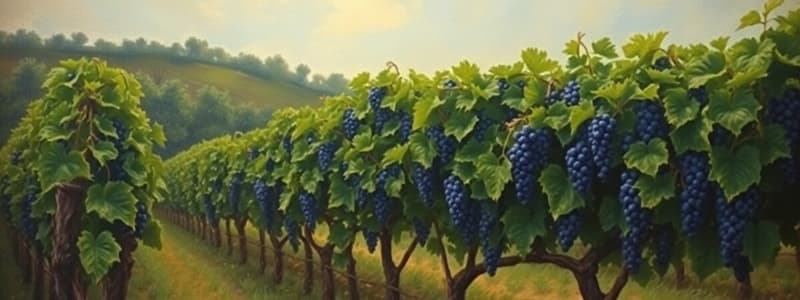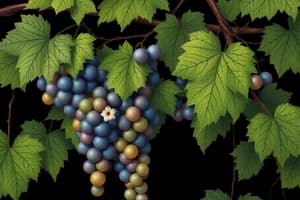Podcast
Questions and Answers
What is the scientific name of the plant primarily used for producing grapes in vineyards?
What is the scientific name of the plant primarily used for producing grapes in vineyards?
- Vitis vinifera (correct)
- Olea europaea
- Citrus sinensis
- Malus domestica
In what era did vines become widely cultivated, particularly with winemaking being embraced by religious orders?
In what era did vines become widely cultivated, particularly with winemaking being embraced by religious orders?
- The Enlightenment
- The Renaissance
- Medieval Times (correct)
- The Industrial Revolution
What is the meaning of the term 'le cep' in the context of vine cultivation?
What is the meaning of the term 'le cep' in the context of vine cultivation?
- The stalk used to support the vine
- The wooden support structure for the vine
- The root system of the vine
- The visible part of the plant, or vine stock (correct)
To what approximate depth can the roots of a vine penetrate into the soil?
To what approximate depth can the roots of a vine penetrate into the soil?
What two key functions do the roots of a vine serve?
What two key functions do the roots of a vine serve?
Besides longevity, what other vital process are the roots of a vine essential for?
Besides longevity, what other vital process are the roots of a vine essential for?
What is the relationship between vine age and root depth?
What is the relationship between vine age and root depth?
What crucial element, necessary for wine production, comes directly before needing vines?
What crucial element, necessary for wine production, comes directly before needing vines?
The visible aerial portion of the vine, crucial for supporting leaves and fruit, is commonly referred to as what?
The visible aerial portion of the vine, crucial for supporting leaves and fruit, is commonly referred to as what?
What does 'lo lat. cippus' refer to in the context of viticulture terminology?
What does 'lo lat. cippus' refer to in the context of viticulture terminology?
What historic group played a significant role in the widespread cultivation of vines and winemaking during the Medieval Times?
What historic group played a significant role in the widespread cultivation of vines and winemaking during the Medieval Times?
Which part of the vine is primarily responsible for drawing up water and mineral nutrients from the soil?
Which part of the vine is primarily responsible for drawing up water and mineral nutrients from the soil?
Why is the depth to which vine roots penetrate the soil important?
Why is the depth to which vine roots penetrate the soil important?
What term is used to describe the visible part of the grapevine, also known as the vine stock?
What term is used to describe the visible part of the grapevine, also known as the vine stock?
What is one factor that affects how deeply a vine's roots can penetrate into the soil?
What is one factor that affects how deeply a vine's roots can penetrate into the soil?
Which of the following best combines the essentials for a successful vineyard according to the text?
Which of the following best combines the essentials for a successful vineyard according to the text?
If a vineyard owner aims to improve the longevity and increase the fruitfulness of their vines, which aspect of the vine should they primarily focus on?
If a vineyard owner aims to improve the longevity and increase the fruitfulness of their vines, which aspect of the vine should they primarily focus on?
What common misconception might someone have about the depth of vine roots?
What common misconception might someone have about the depth of vine roots?
Understanding that vines were cultivated by religious orders gives insights into what aspect of winemaking history.
Understanding that vines were cultivated by religious orders gives insights into what aspect of winemaking history.
How does understanding 'le cep' help in vineyard management?
How does understanding 'le cep' help in vineyard management?
Flashcards
Vitis vinifera
Vitis vinifera
Vitis vinifera is the plant species primarily used for making wine.
Vine stock (le cep)
Vine stock (le cep)
The vine stock, also known as 'le cep', is the visible part of the grapevine plant, like a wooden stem.
Vine Root Depth
Vine Root Depth
The roots of the vine penetrate the soil to a depth of up to 7 meters (22 feet), depending on the age of the vine and the soil.
Vine Root Functions
Vine Root Functions
Signup and view all the flashcards
Historical Cultivation
Historical Cultivation
Signup and view all the flashcards
Study Notes
- To make wine, grapes are needed, and to get grapes, vines are needed.
- The plant is called vitis vinifera.
- Vines were planted by the Romans in the 365th century.
- Vines became widely cultivated in Medieval times, and winemaking was taken up by religious orders.
- At first glance, a wooden stem is visible.
- The vine stock, "le cep", is the visible part of the plant, known as "cippus" or stake in Latin.
- Roots can penetrate the soil down to a depth of 7m (22 feet) depending on the age of the vine, and the soil in which it grows.
- Roots are essential to longevity and fruitfulness.
- Roots draw up the water and mineral nutrients.
Studying That Suits You
Use AI to generate personalized quizzes and flashcards to suit your learning preferences.




